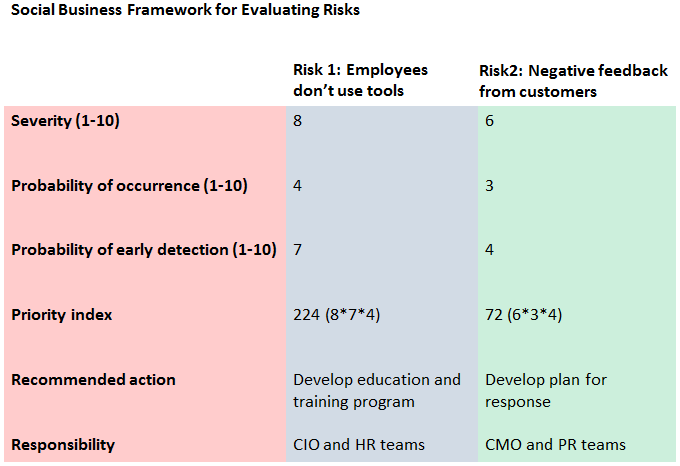I just finished reading “The New Supply Chain Agenda,” by Reuben E. Slone, J. Paul Dittmann, and John T. Mentzer which is a great book for anyone interested in supply chain management. One of the chapters in the book talked about evaluating risks for supply chain initiatives and I thought the model they used makes perfect sense for the social business space. It’s not overly complicated and if enterprise organizations can use this framework for multi-million dollar supply chain initiatives then it should work just fine for organizations getting involved in social business. I’m going to modify it in the near future but here is the basic framework.

Step 1
The organization needs to write down the risks that it perceives as a result of getting involved in social business. I just arbitrarily picked two risks above which were “employees don’t use tools” and “negative feedback from customers.” I would recommend a cross-functional meeting as opposed to just having someone from PR or marketing coming up with all of the risks.
Step 2
Go through each risk and fill out the first four elements, leave the recommended action and responsibility pieces blank until you decide which risks you are going to address, something we will discuss below. If we use Risk 1 above as an example we can see that the severity level (out of a scale of 1-10) of employees not using internal collaboration tools is an 8, the chances of that actually happening are a 4 and the probability of detecting that risk early on is a 7. Finally, multiple these three numbers together to get a “priority index” which in our example for Risk 1 is 224. Again, I just assigned these numbers randomly but these numbers should come from a discussion with your team, the point isn’t to get to some exact number but to help compare the risks to one another in relative terms.
Step 3
Go through this process for all of the risks you have identified to get the “priority index” number. Once this process is done your team needs to decide how many risks it can feasibly address immediately, perhaps it’s just the top 5 or 10, maybe it’s all of them. In the example above I just selected two risks. The priority index score will help you and your team decide how to prioritize the risks your organization is being faced with.
Step 4
Once you have the list of risks you are going to deal with (say the top 10) you can go ahead and fill out the bottom two areas which are the recommended action to deal with the risk and whose responsibility it is to deal with the risk.
Going through this process isn’t very difficult but the value it will provide to your team in terms of evaluating, prioritizing, and mitigating perceived risks should be great. Other factors will also need to be considered such as “what resources are going to be required to for the action.” Let’s use this as our starting ground to help us deal with risks in the social business space. I’m working on some other things around this which will help further the model and the discussion around risk in the social business space.
Comments